| Columns Retired Columns & Blogs |
seems like a no brainer for a rich, musical, amp/pre-amp combo. Tubes + sort of Class A = something I want to try.
I measured the performance of the Schiit Freya + with my Audio Precision SYS2722 system, checking some of the results with the magazine's top-line APx500. The preamplifier preserved absolute polarity (ie, was noninverting) with both balanced and unbalanced inputs and outputs and in all three output modes. Its XLR jacks are wired with pin 2 hot, the AES convention. The maximum gain depended on whether the tube stage was operating and whether I was using the unbalanced inputs and outputs or the balanced inputs and outputs. In passive mode or with the solid state buffer, the maximum gain with the single-ended inputs at the single-ended output was –6.1dB. It was –0.08dB at the balanced output for both the balanced and unbalanced inputs, ie, just below unity gain. With the tube stage engaged, the maximum gain at the balanced outputs was just below the specified 12dB for both types of inputs, at 11.74dB, and 6dB lower at the single-ended outputs.
The Schiit's unbalanced input impedance was close to the specified value, at 9.9k ohms at 20Hz and 1kHz, dropping slightly to 9.1k ohms at 20kHz. As expected, the balanced input impedance was twice the single-ended figure. The active balanced output impedance was the same with or without the tube stage operating. It was close to 810 ohms at 1kHz and 20kHz but increased to 6900 ohms at 20Hz. The buffered unbalanced output impedance at 1kHz and 20kHz was inconsequentially higher than the specified 75 ohms, at 90 ohms. However, it rose to 3100 ohms at the bottom of the audioband. With the tube stage operating, the unbalanced output impedance was 3267 ohms at 20Hz and 1200 ohms at 1kHz and 20kHz.
As is always the case with passive preamplifiers, the output impedance depended on the setting of the volume control. The preamplifier's balanced output impedance was lowest with the volume control set to its maximum, at 638 ohms. (This figure includes the Audio Precision's source impedance of 40 ohms.) The output impedance increased to more than 5k ohms at settings from –4dB to –15dB but dropped to 2.4k ohms at settings of –20dB and below.
Without the tube stage but with the solid state buffer, the preamplifier's frequency response extended to 200kHz, with excellent channel matching (fig.1, blue and red traces). However, the low frequencies started to roll off below 100Hz, reaching –0.75dB at 20Hz. This slight rolloff remained with the tube stage engaged, but now the right channel (fig.1, gray trace) was 0.1dB lower than the left (green trace) and the ultrasonic output started to roll off above the audioband, reaching –1dB just above 100kHz. The channel matching was preserved at lower settings of the volume control, but the increase in output impedance at low frequencies meant that the bass rolled off prematurely with low impedances. Into 600 ohms, for example, the response at 100Hz was down by 3dB.
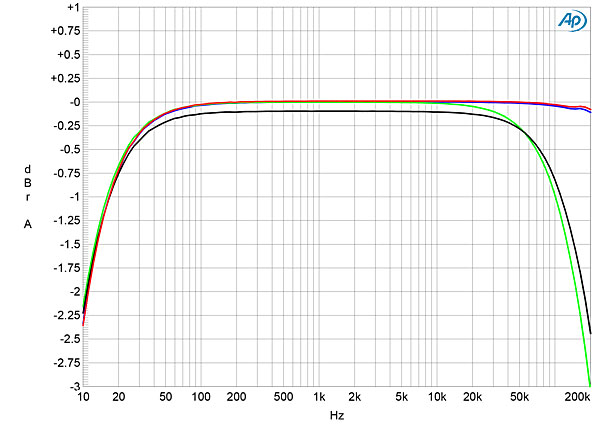
The Schiit preamp's channel separation was superb, at >120dB in both directions below 1kHz, decreasing only slightly at the top of the audioband (not shown). The Freya + offered extremely low noise: The wideband, unweighted signal/noise ratio, measured at the buffered balanced outputs with the unbalanced inputs shorted to ground and the volume control set to its maximum, was 98.9dB in the left channel, 102.4dB in the right, both ratios ref. 2V output. Restricting the measurement bandwidth to the audioband increased the S/N to a superb 117.15dB in both channels, while switching an A-weighting filter into circuit further improved this ratio, to 120dB, agreeing with the specification.
With the tube stage active and with the volume control again set to its maximum, the Schiit's S/N ratios were 10–11dB lower, ie, the noisefloor had risen by approximately the amount of gain added by the tubes. (The noise, though, was still very low in level in absolute terms.) This can be seen in fig.2, which shows the low-frequency spectra in active mode with (blue and red traces) and without (green and gray traces) the tube stage. As well as increasing the level of the random noisefloor, the tubes also introduce power-supply–related spuriae at 60Hz and 120Hz, especially in the right channel (red trace). Even so, all the spuriae are very low in level. The Freya + is still a very quiet tube preamplifier.
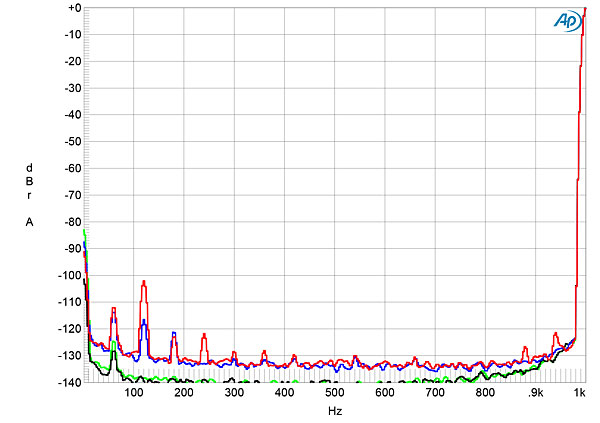
In solid state buffered mode with balanced input and output, the THD+noise in the Freya + reached 1%—our usual definition of clipping—at 6.7V (fig.3). Note the extremely low level of THD+N in this graph at levels below 2V: just 0.0004%! With the tube stage (fig.4), the Freya + clipped at just above 20V. While the distortion at lower voltages was higher than it had been with the buffered output, it was still very low. This can also be seen in fig.5, which plots the THD+N percentage against frequency at 1V into 100k ohms, a level where actual distortion is starting to rise above the noisefloor. Commendably, the THD+N doesn't change significantly with frequency, particularly with the solid state buffered output (green and gray traces). This graph also shows that the tubed output's right channel (red trace) has more distortion than the left (blue). This may well be due to this channel's tubes not being as well-matched as the left channel's, perhaps due to age.
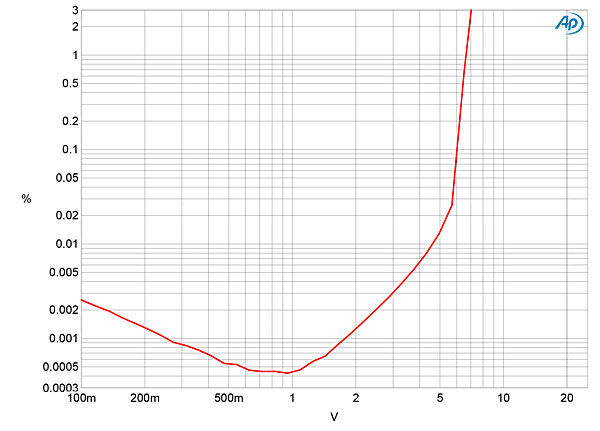
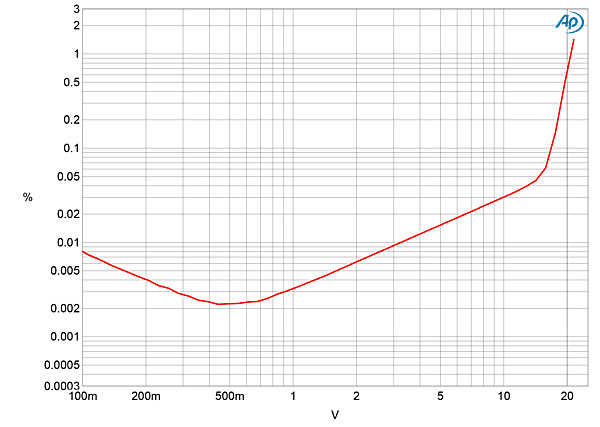
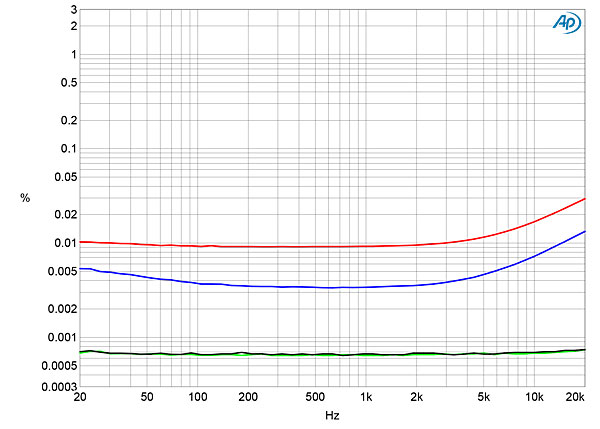
With a balanced 1kHz tone at 1V into 100k ohms from the balanced, solid state buffered output and the volume control set to its maximum (fig.6), the third harmonic was the highest in level, at just –110dB (0.0003%). With the input signal changed to a single-ended 1kHz tone (fig.7), the third harmonic rose slightly, but the highest-level harmonic was now the second, at –88dB (0.004%). With the tube stage and the same output level and load, the second harmonic was still the highest in level (fig.8), more so in the right channel than the left, but the noisefloor had risen by the expected 10dB. The spectrum was the same for both balanced and single-ended input signals.
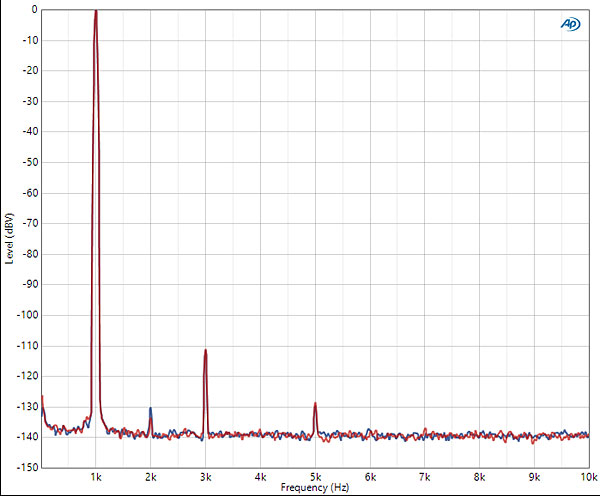
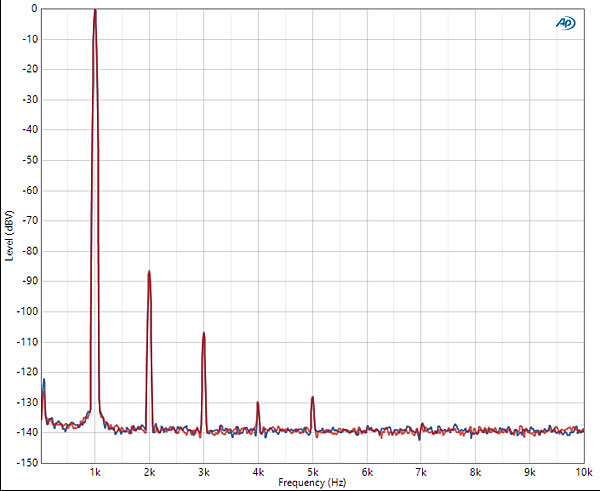
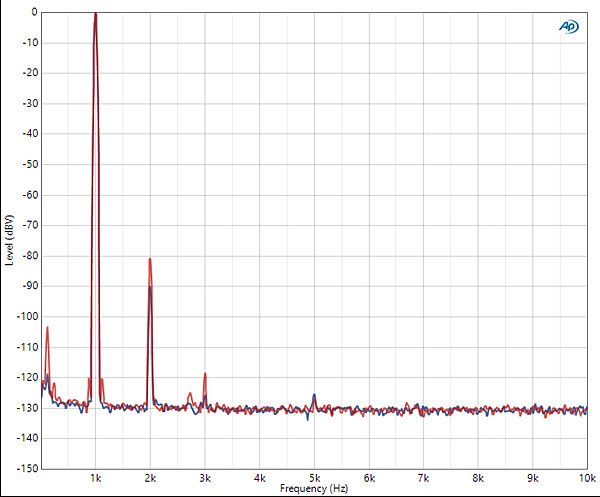
When tested for intermodulation distortion with an equal mix of 19kHz and 20kHz tones at a peak level of 1V into 100k ohms, with the solid state buffered output driven by a balanced input signal (not shown), the second-order difference product at 1kHz lay below the very low noisefloor. Changing to a single-ended input signal, the difference product appeared at a still very low –93dB (fig.9), and higher-order products at 18kHz and 21kHz were now visible. Repeating the measurement with the tubed output at the same output level, the 1kHz product lay at –98dB with both unbalanced and balanced input signals (fig.10).
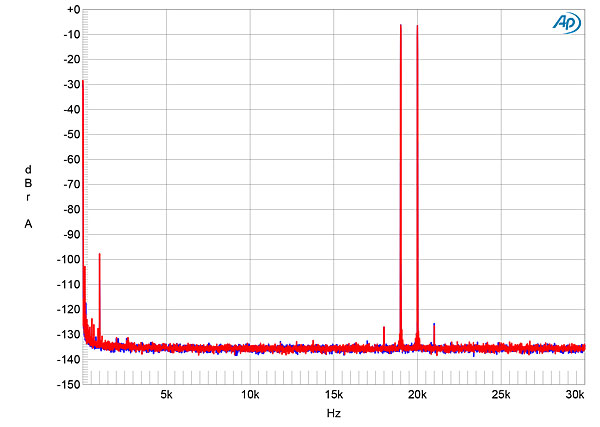
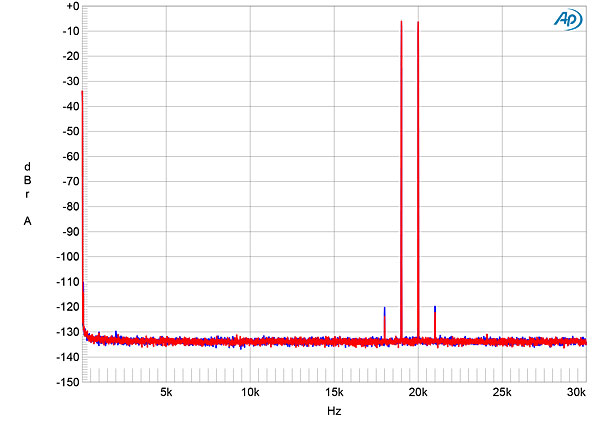
With its very low levels of both noise and distortion, even with the tube stage active, the Schiit Freya + preamplifier's measured performance is superb, matching or better than the specifications listed on Schiit's website. My only caution is that the high output impedance at low frequencies from all the outputs will result in a lightweight balance with power amplifiers that have an input impedance much below 10k ohms. This would not have been a problem with KR's Benchmark AHB2 and NAD C 298 amplifiers, which have balanced input impedances of 48k ohms and 100k ohms, respectively.—John Atkinson

seems like a no brainer for a rich, musical, amp/pre-amp combo. Tubes + sort of Class A = something I want to try.

I've owned many Schiit pieces, even their very first design.
Stereophile's reviewers personally introduced me to the Schiit people at RMAF 2011, I've owned Schiit gear ever since !
Schiit gear seems consistently outstanding in two ways: 1.) Sound Quality and 2.) Value for Money !!
The Schiit gear is reliable and retains an amazing 80% of it's MSRP on the used market. ( eBay )
The Schiit Valhalla 2, with Russian Tubes , continues to be one of finest sounding Pre-Amps I've ever discovered, phew!!!!!
But, Schiit continues to insist on retaining two easily corrected problems :
1.) The control labelling seems indeciferable
2.) The Power Switch is on the back
It seems puzzling that Schiit's designers created such a wonderful Company, built products that are so widely loved and even cherished yet insist on making us cope with such easy to remedy problems.
I properly label my gear so that it's easily readable in the dark and even build an outboard power switch so that I don't have to reach around the back.
Schiit is an Outstanding Company, they build far better quality then they charge for, they consistently deliver sound quality, don't have reliability issues and their stuff re-sells Globally..
I wish it didn't have a Shity name.
Tony in Florida

" by tonykaz: It seems puzzling that Schiit's designers created such a wonderful Company, built products that are so widely loved and even cherished yet insist on making us cope with such easy to remedy problems."
by JA: "My only caution is that the high output impedance at low frequencies from all the outputs will result in a lightweight balance with power amplifiers that have an input impedance much below 10k ohms."
Probably easy fix with a larger coupling output cap, and many of today's amps are some at 2kohm input impedance (no bass then from this pre into them)
Cheers George

Russian Glass Tubes are NOW Sanctioned ! OUCH
I wonder if this politically correct site will take this report down ? , Stoddard worries that the moderated Head-Fi will take-down his Russian Tube problem report.
This political censoring is nonsense
Tony in Florida

Russian Glass Tubes are NOW Sanctioned ! OUCH
I wonder if this politically correct site will take this report down?
First, the Freya+ (and its Russian tubes) were assembled and reviewed long before the invasion of Ukraine.
Second, the Freya+ permits us to express our position by actively bypassing the Russian tubes on a daily basis. (I don't know how the Freya+ will function if you pulled them.)
I pronounce it like SKITE if anyone asks lol.
I choose not to pronounce it at all.

for us to endure .
Tony in Florida


related to Fertiliser manufacture originate in Mother Russia, those imports are also sanctioned.
Of course, we can always eat Cake - can't we ?
Tony in Florida

Just wait for it. I probably purchased my last high dollar vinyl for now. A $60 MOFI release of ELO Eldorado. I suspect companies like Schiit will do well with their low price offerings, as consumers navigate the minefields of high inflation, shortages, and whatever else is coming next.

I'm hearing that the supply of PVC for the vinyl record injection moulding is doubtful for future months.
This stuff is very much imported and dependant on Oil imported from Sanctioned sources.
We are all intended to feel the pain, it is said.
Tony in Florida

I would love to see a review of the Saga S. I have one, and have a similar impression to KR as far as the buffer stage sound. For $299, it is an extremely clean sounding preamp with excellent build quality. I, like Tony, just wish they didn't have that name. I pronounce it like SKITE if anyone asks lol.

and delighted to see it get class A in Stereophile. I own one and love it with some upgraded tubes. I think the tubes took it to a whole other level in my system. I really like the tube circuit it just fleshes out the bottom in my system and adds a little warms, it's just right. I was thinking of trying a really expensive tube preamp to compare but I might not even bother. Between this an the Decware Zen triode amp any regular Joe can experience sound that is near as good as it gets and get a no BS product where you get real value for you dollar.